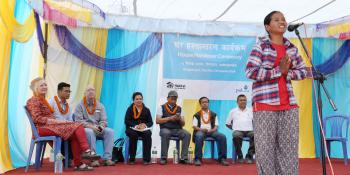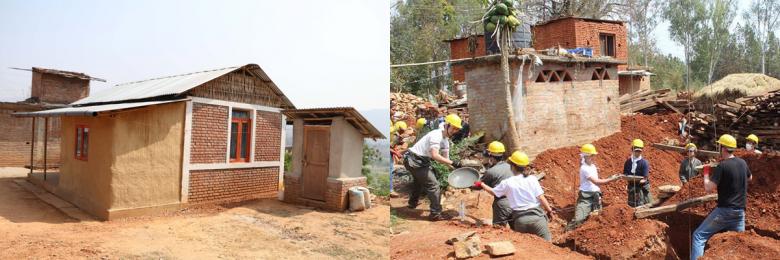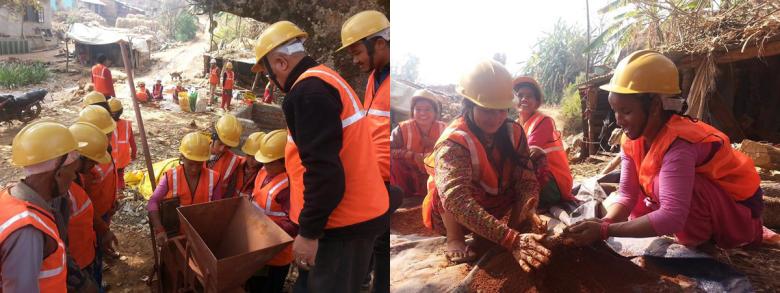
The subtitle goes here.
By the second anniversary of the 2015 earthquakes, Habitat Nepal has worked with 87 families in Pipaltar to rebuild their homes and improve their health and livelihood prospects, among others.
MANILA (April 25, 2017) – The Pipaltar community is getting back on its feet two years after Nepal was hit by devastating earthquakes in 2015. Under the owner-driven reconstruction approach, a total of 87 families have rebuilt their houses with Habitat for Humanity Nepal. Families have the option of adding a second floor to the one-story houses as they have the means.
Pipaltar is located in Kavrepalanchowk, one of the hardest hit districts. In 2015, Nepal was struck by major earthquakes – one measuring magnitude-7.8 on April 25 and another of magnitude-7.4 on May 12. According to government figures, the earthquakes left over 893,000 houses destroyed or damaged and caused more than 8,850 deaths. Within a few weeks of the disaster, Habitat had started distributing temporary shelter kits to affected families. Habitat’s effort was among the case studies highlighted in the 2015-2016 edition of the Shelter Projects series by the Global Shelter Cluster. Read more.
While Pipaltar used to be predominantly agricultural, local community members who have received masonry training now have an additional source of income. Among the 55 local community members who have been trained, Sharada is the first and only female mason. She and her extended family of eight lost their family home during the earthquakes.
At the dedication ceremony on April 18, Sharada said: “When the CEO of Habitat for Humanity International visited Pipaltar one-and-half years ago, I had expressed my desire to be a part of the community rebuilding process. Then I was not sure how a simple village girl like me could contribute. Now I am a certified skilled mason and I have lent my support to rebuilding houses in Pipaltar and neighboring communities. For me, this is like a dream come true. Thank you for the opportunity. It is truly empowering!”
It is not only Sharada’s life that has been transformed. All the 87 families who are now living in their rebuilt houses can look to positive changes. They used to share the same quarters with their livestock. Now, the animals are kept in a separate area, resulting in a more hygienic, healthier living environment.

Partnering with Architecture Sans Frontières Nepal in all three locations, Habitat Nepal aims to serve 3,500 families who are rebuilding their homes. Services that are provided include house designs, referrals for masons and material supply, engineering consultation and government coordination. Out of these 3,500 families, Habitat and its donors are supporting about 1,000 most vulnerable families with labor and material support because the government’s subsidies are insufficient for them to complete rebuilding their houses.
As the affected families recover from the earthquakes, Habitat’s international volunteers are right beside them, working together to build strong, stable homes and communities. Locally based volunteer teams from corporations have also made significant contributions of their time, labor and resources.
With support from the government and Habitat Nepal, families are building strength through a community-driven reconstruction approach. Communities are empowered to make informed choices about house construction, water, sanitation and other shared resources.
Gender equality and social inclusion are promoted through training in the Participatory Approach for Safe Shelter Awareness that is conducted by Habitat Nepal’s local partners. More than 500 members of PASSA groups have been trained, supporting the reconstruction initiatives in their communities and strengthening local capacity to rebuild after a disaster.

Local communities in Panchkhal, Kavrepalanchowk, and Tupche, Nuwakot, have been trained in making affordable, environmentally friendly compressed stabilized earth bricks using locally available soil. The bricks will be used in building houses for the most vulnerable families who have been identified by PASSA group members.
Read a report about Habitat Nepal’s post-disaster rebuilding efforts a year after the earthquakes.
Habitat for Humanity continues to work in the world’s most disaster-affected region with the ultimate goal of assisting families into permanent housing solutions. In the Philippines, Virgilio and Evangeline were utterly shaken when Typhoon Haiyan destroyed their house. Building a house with Habitat Philippines turned their life around. “We are more stable because we own this house,” said Virgilio. Learn more.